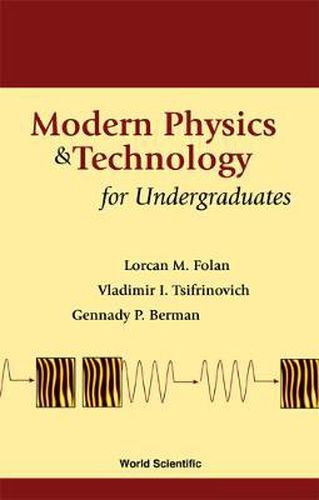Readings Newsletter
Become a Readings Member to make your shopping experience even easier.
Sign in or sign up for free!
You’re not far away from qualifying for FREE standard shipping within Australia
You’ve qualified for FREE standard shipping within Australia
The cart is loading…






This textbook connects an undergraduate course in physics with modern science and technology. The first part of the book gives an overview of hot directions in modern physics and technology. The second part contains problems which are related to those directions. Where necessary, the problems have detailed solutions. The text also includes a brief review of undergraduate physics. A huge chasm has developed between modern science and undergraduate education. The result of this chasm is that students who are graduating from college are unable to exploit the many opportunities offered by modern science and technology. Consequently, student interest in undergraduate physics is very low. The authors purpose to try to bridge this chasm between modern science and technology and undergraduate education. Modern science and technology widely uses the methods of classical physics, but these modern applications are not reflected in the problems on physics often suggested to students. Solving practical problems is a very effective way to inform students about contemporary science, to show the important relationships between modern and classical physics, and to prepare them for future activity in the modern technological environment. The authors have prepared a set of problems based on some of the latest developments in science and technology which can be solved using the classical physics accessible in a standard undergraduate programme.
$9.00 standard shipping within Australia
FREE standard shipping within Australia for orders over $100.00
Express & International shipping calculated at checkout
This textbook connects an undergraduate course in physics with modern science and technology. The first part of the book gives an overview of hot directions in modern physics and technology. The second part contains problems which are related to those directions. Where necessary, the problems have detailed solutions. The text also includes a brief review of undergraduate physics. A huge chasm has developed between modern science and undergraduate education. The result of this chasm is that students who are graduating from college are unable to exploit the many opportunities offered by modern science and technology. Consequently, student interest in undergraduate physics is very low. The authors purpose to try to bridge this chasm between modern science and technology and undergraduate education. Modern science and technology widely uses the methods of classical physics, but these modern applications are not reflected in the problems on physics often suggested to students. Solving practical problems is a very effective way to inform students about contemporary science, to show the important relationships between modern and classical physics, and to prepare them for future activity in the modern technological environment. The authors have prepared a set of problems based on some of the latest developments in science and technology which can be solved using the classical physics accessible in a standard undergraduate programme.